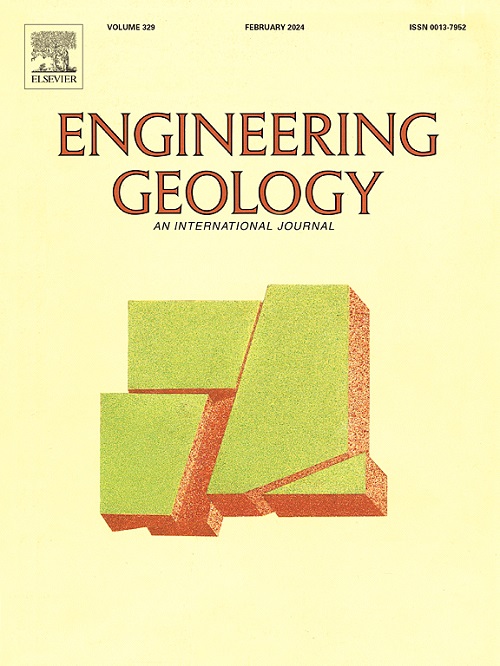Study on the deformation mechanism of chair-like bedding rock landslides under the coupling effect of geological and hydrological factors
IF 8.4
1区 工程技术
Q1 ENGINEERING, GEOLOGICAL
引用次数: 0
Abstract
Chair-like bedding rock landslides are prevalent in the Three Gorges Reservoir area (TGRA), necessitating further investigation into their inducing mechanisms. This study focuses on the Muyubao and Tanjiahe landslides, conducting a comparative analysis of their deformation characteristics and mechanisms while comprehensively considering geological and hydrological factors. The findings indicate that the Muyubao landslide was primarily triggered by the combined effects of rainfall during the water storage period and the rise of the reservoir water levels (RWL), with a threshold of approximately 165 m. In contrast, the Tanjiahe landslide was influenced by a rapid drawdown in RWL, heavy rainfall, and a high RWL, with a threshold of around 175 m. Both landslides exhibited a clear response to the rise in groundwater levels in the steep sections, with significant deformation occurring when groundwater levels reached 175 m (Muyubao landslide QSK1) and 245 m (Tanjiahe landslide QSK2). Notably, variations in landslide morphology, permeability coefficients, and fluctuations in groundwater levels can facilitate the mutual conversion between different landslide types (seepage-driven and buoyancy-driven). To investigate the influence of chair-like slope morphology on landslides, eight landslide models were constructed, featuring a range of dip angles for the rock formation (15° to 30°) and varying length ratios of gentle to steep sections (2:8 to 5:5). The UDEC Code was employed to simulate and analyze the governing effects of slope morphology on landslide deformation and evolution. Through a comparative analysis of the Muyubao, Tanjiahe, Jiuxianping, and Qianjiangping landslide cases, we examined the significant influence of landslide morphology and permeability coefficients on landslide behavior. The results indicate that the length ratio of gentle to steep section is a crucial parameter. When this ratio exceeds 2:8, the landslide is characterized by pushing deformation; conversely, when the ratio is lower, it tends to exhibit overall movement. Additionally, geological factors affect groundwater seepage and water level variation under the influence of rainfall and reservoir water, resulting in distinct deformation characteristics and mechanisms across different landslide types. Factors such as slope angle and the length of the gentle section influence the extent of the submerged area, leading to varied landslide responses to rise of the RWL.
地质水文因素耦合作用下椅状顺层岩质滑坡变形机理研究
三峡库区椅状顺层岩质滑坡普遍存在,其诱发机制有待进一步研究。本文以木鱼堡滑坡和谭家河滑坡为研究对象,在综合考虑地质水文因素的情况下,对其变形特征和机理进行了对比分析。结果表明:木鱼堡滑坡主要由蓄水期降雨和水库水位上升共同作用引发,水位上升阈值约为165 m;而谭家河滑坡则受水位线下降快、降雨强、水位线高的影响,水位线阈值在175 m左右。两种滑坡在陡坡段对地下水位的上升均有明显的响应,在地下水位达到175 m(沐鱼堡滑坡QSK1)和245 m(谭家河滑坡QSK2)时均发生了明显的变形。值得注意的是,滑坡形态、渗透系数和地下水位波动的变化有助于不同滑坡类型(渗流驱动型和浮力驱动型)之间的相互转换。为了研究椅状边坡形态对滑坡的影响,我们构建了8个滑坡模型,这些模型具有不同的岩层倾角(15°至30°)和不同的平缓段与陡峭段的长度比(2:8至5:5)。采用UDEC规范模拟分析了边坡形态对滑坡变形演化的控制作用。通过对木鱼堡滑坡、谭家河滑坡、酒仙坪滑坡和钱江坪滑坡的对比分析,探讨了滑坡形态和渗透系数对滑坡行为的显著影响。结果表明,缓陡段长度比是一个关键参数。当该比值超过2:8时,滑坡表现为推动变形;相反,当比率较低时,它往往表现出整体的运动。此外,地质因素还会影响降雨和水库水对地下水渗流和水位变化的影响,导致不同滑坡类型具有不同的变形特征和机制。坡角、平缓段长度等因素影响淹没面积的大小,导致滑坡对RWL上升的响应各不相同。
本文章由计算机程序翻译,如有差异,请以英文原文为准。
求助全文
约1分钟内获得全文
求助全文
来源期刊

Engineering Geology
地学-地球科学综合
CiteScore
13.70
自引率
12.20%
发文量
327
审稿时长
5.6 months
期刊介绍:
Engineering Geology, an international interdisciplinary journal, serves as a bridge between earth sciences and engineering, focusing on geological and geotechnical engineering. It welcomes studies with relevance to engineering, environmental concerns, and safety, catering to engineering geologists with backgrounds in geology or civil/mining engineering. Topics include applied geomorphology, structural geology, geophysics, geochemistry, environmental geology, hydrogeology, land use planning, natural hazards, remote sensing, soil and rock mechanics, and applied geotechnical engineering. The journal provides a platform for research at the intersection of geology and engineering disciplines.
 求助内容:
求助内容: 应助结果提醒方式:
应助结果提醒方式:


